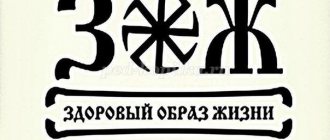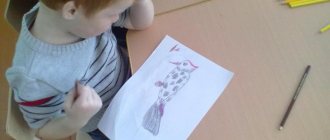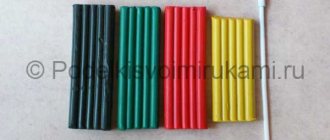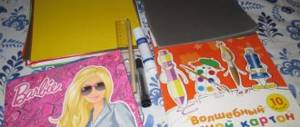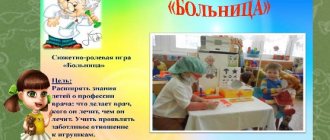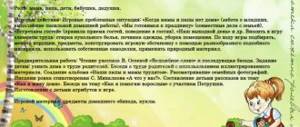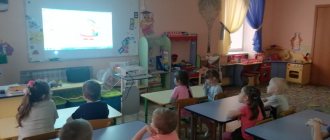Summary of the role-playing game “Barbershop”
In the middle group
Integration of educational areas: “Cognitive development”, “Socio-communicative development”, “Speech development”.
Participants: children of the middle group, teacher.
Tasks:
- To develop children's interest in role-playing games, to help create a play environment, and to establish interaction between those who have chosen certain roles. Teach children to implement and develop the plot of the game.
- Form friendly relationships in the game, the ability to change your role behavior in accordance with the different roles of partners. Learn to carry out game actions according to verbal instructions.
- Enrich children's knowledge about the work of a hairdresser, cultivate respect for the work of a hairdresser.
- Activation of the dictionary: hairdresser, master, scissors, comb, hairstyle, hairdryer, haircut, cuts, bangs, shaves, refreshes with cologne, styling foam, roll on curlers, pay money to the cash register.
- Preliminary work:< /p> 1. The teacher’s story about the profession of a hairdresser, about work in a hairdresser;< /p> 2. Examination of paintings, photo illustrations about the work of a hairdresser;< /p> 3. Conversation with children “How I went to the hairdresser with my mother” hairdresser";< /p> 4. Excursion to the hairdresser (with parents). Observing the work of the master; < /p> 5. Reading a fairy tale by S.Ya. Marshak “Cat’s House”;< /p>Reading the stories of B. Zhitkov “What I saw”, S. Mikhalkov “In the hairdresser”;
- Make and collect attributes for the game: writing, aprons for hairdressers, scissors, combs, money, towels, used clean boxes and jars of creams, perfumes, deodorants, shampoos;< /p>Didactic games “What we saw, we will not say, but We’ll show you what we did.” “What are these items for”;
- Preparing the space in the play area for the game "Barbershop".
Roles that children can play:
- hairdresser (female and male master) or all-round master;
- cashier-administrator;
- clients.
Game actions
- Putting a cape on the client.
- Combing.
- A haircut.
- Washing head.
- Toweling.
- Blow dry.
- Curling with curlers.
- Braiding.
- Tying ponytails.
- Pinning hairpins.
- While your hair is drying, you can offer the client to look at a fashion magazine.
Developmental subject-game environment
- Mirror.
- Bedside table, shelf for storing game attributes.
- Different types of combs. Combs should have sparse, non-sharp teeth, short, rounded handles.
- Shampoo bottles have a bright, attractive shape.
- Curlers for one turn of the strand.
- Plastic scissors (inoperative machine for men's haircuts).
- Toy hair dryer.
- Cape for a client.
- Apron-cape for a hairdresser.
- Towel.
- Hairpins, elastic bands, bows, you can have one New Year's wig.
- Magazine with hairstyle samples.
Progress of the game
Surprise moment.
The teacher announces to the children that the postman has brought a letter. He opens the letter, reads the address and the text: “Hello, the children of the middle group of kindergarten 2027. I am Aunt Cat, the kittens and the caretaker Cat invite you to visit their new home.”
The teacher suggests that before going on a visit you need to visit the hairdresser.
— Guys, have you been to the hairdresser? Who works there? Do you know what the profession of a person who cuts and does hair is called? That's right hairdresser. Today the master hairdresser will not have time to serve everyone, I suggest visiting the salon one by one.
Children and the teacher go to the “Barbershop” play area.
(The teacher can take on the role of a hairdresser himself (a universal master, explaining to the children his role in the game) and give the children a model of actions and communication. “Please come in, sit down.”
“What hairstyle would you like for yourself?” “Should I braid my hair or tie it in a ponytail?” “Do you want two braids? Very good" "Please!" "Did you like it?" “I’m glad you liked it too.” “Come to us again, I’ll do a new hairstyle.” “Please, next!”
Educator: (helps distribute roles) Ilya - you are a male master and will work in the men's room, and you, Stesha, are a female master and will work in the women's room. Look at your jobs.
Roma, Misha and Alisa are visitors.
Stesha: No, it’s better that you be the female master, and I will be the visitor.
Educator: Please, I will be a female master who wants to cut their hair or do their hair.
Roma: I want to get a haircut. Ilya: Hello, go to the men's room, take a seat. What hairstyle do you want...?
Misha: And I want to get a haircut and put on some cologne.
Ilya: Okay.
Alice and Katya: We want to do a beautiful hairstyle.
Educator: Come on, girls, to the women's room. What tools do hairdressers use? What do you wash your hair with? What else is used when washing your hair? (The teacher leads the children to remember the hairdresser’s equipment.)
Children's answers: special scissors, electric machines, towels, shampoos, hair dryer, conditioner
Ilya: Misha, do you need to wash your hair?
How to cut it?
Roma: Yes, wash it, but I want my hair like my dad’s!
Ilya begins to wash Misha’s hair, imitating a shower in one hand and shampoo in the other. After washing, he takes the scissors and starts cutting, then blow-dries it, asking whether Misha likes it or not?
Misha: I like it. (Admires himself in the mirror.) Pays for the services.
Then Ilya invites Roma to the chair and does the same work with him as with Misha. At the same time, work takes place in the women's room. The teacher-hairdresser begins to work with the girls' hair.
Stesha: I already wanted to be a hairdresser myself.
Educator: Okay, put on your hairdresser's uniform.
The teacher helps with the choice of shampoo, for what type of hair? What air conditioner? Hair rinse.
Stesha: Katya, should you style your hair with foam or hairspray?
Katya: Varnish is better.
Girls clients pay for the work.
All the children are watching Stesha work.
When the work in the women's room is finished, the teacher draws attention to Roma's beautifully cut hair and Lisa's styled hair and invites them to remember. What do hairdressers do and what is the result?
(Children form relative adjectives: beautiful hairstyle, styled hair, good haircut.)
Ways to exit the game
- “What beautiful and varied hairstyles you all have! Well done to our hairdressers. And now our hairdresser is closing, but tomorrow it will be open again. Be sure to come."
- If the game does not die down, then you can warn the children in advance that the hairdresser will close soon, there is very little time left, so the last client is being served. Children who didn't have time can come up with their own hairstyle and come tomorrow. This way, all the children will participate in the game and no one will get upset.
Game results:
The barber shop game is over. Did you like her? What roles did you perform? What they were doing?
Educator: And tomorrow the hairdresser is waiting for its clients again. When all the children have beautiful hairstyles, you and I can go to visit Aunt Cat.
